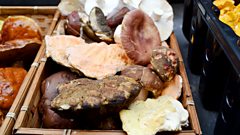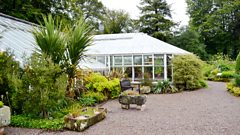
13/08/2015
The Kitchen Garden visits Scotland's home of heritage gardening, Threave Gardens near Castle Douglas, and talks to gardeners Brian Corr and Michael Lawrie.
Edible hogweed, heritage produce and Scotland's only bat reserve. This week, The Kitchen Garden is at Scotland's home of heritage gardening, Threave Gardens near Castle Douglas.
Threave Gardens is the only National Trust for Scotland property that was specifically created for educational purposes. The gardens are an open air classroom for horticultural students learning the art and craft of heritage growing. Threave gardeners Brian Corr and Michael Lawrie describe the garden and discuss why need to preserve both our heritage varieties and out traditional gardening practices.
One woman's weed is another man's lunch - Forager Mark Williams takes Horticulturalist Frances Pringle for a forage around some of the less cultivated areas of Threave to look for some lunch, while also looking at how to differentiate between the dangerous giant hogweed from its smaller edible relative.
Last on
Clip
-
![]()
Threave Gardens and Estate forage
Duration: 25:44
Kitchen Garden Plot Blog - The diary of a ‘grow your own’ enthusiast.

Grow your own enthusiast Richard Crawford, shares the growing pains and pleasures of his summer down on the plot at Hawthorn Allotments in Inverness.
I really don’t recall having such a late season as this; everything seems to be so far behind. Although I have already picked some of my dwarf beans, it is only some and I am struggling to find anymore that are anywhere near ready. All we need is a spell of warmth – just a couple of weeks please! I have now picked most of my broad beans; I like to eat them when they are tender and sweet which means getting them before the Hilum (the bit that attaches the bean to the pod) turns dark. I have bags of beans safely stored in my freezer, which I hope will see me through to the next harvest (fat chance!!).
This season has led to a proliferation of the potato apple (at least that’s what I have always known I as). I have had a few people comment on them and ask what they are; well, DO NOT EAT them! They look like little cherry tomatoes that are growing on the potato plant and of course, as I have said before, the two plants are related and these potato apples are the equivalent of tomatoes. Potatoes and tomatoes belong to the Nightshade family and most of us are aware that Deadly Nightshade is very poisonous. Well, these fruits also contain poison – Solanine. However, this is how potatoes reproduce and develop different strains. The tubers (the potatoes we eat) will make more of the same plant but the flowers could get pollinated from different varieties, so the fruit can be picked and the seeds grown, and you never know! You could have a new variety of spuds….. This won’t happen every year – typically, we need pretty cool conditions in the spring. Wait! Doesn’t that happen every year in the Highlands?
I have sown a few more cauliflowers, hoping to squeeze in one more crop before the end of the season. I am continuing to plant radishes, lettuces and a few spring onions. Time to think about sowing spring cabbages and it is getting towards the time for planting Japanese onions. My onions are poor this year; I got them in during a warm spell, then got hit by the cool weather and despite my attentions, they are not at all good. Many have bolted and the rest are small. Time yet though! If we get some prolonged good weather, I may yet have a good crop and I hope the comfrey tea will help. It seems that the people who got theirs in at the back end of last year have done the best; there are some fantastic onions in some plots.
Ìý
Potato fruit

Broadcast
- Thu 13 Aug 2015 13:30Â鶹ԼÅÄ Radio Scotland


